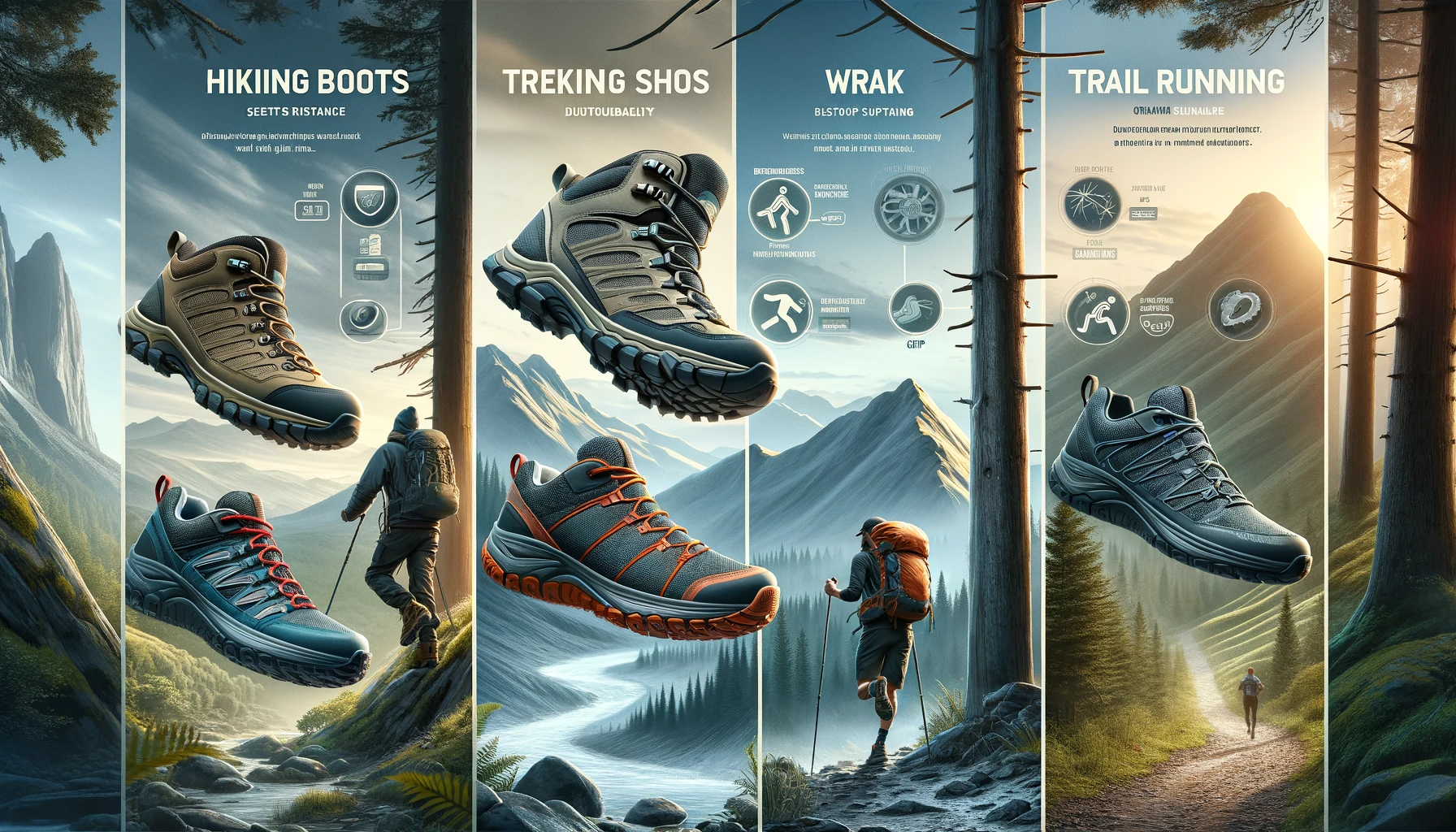Footwear Fit for Adventure: Choosing Hiking, Trekking, and Trail Running Shoes
Engaging in outdoor activities such as hiking, trekking, and trail running demands specialized footwear that can withstand rugged terrains and unpredictable weather conditions. However, understanding the differences between hiking shoes, trekking shoes, and trail running shoes is crucial to ensure you select the appropriate pair for your adventure. In this comprehensive guide, we will delve into the unique characteristics of each type of footwear and provide valuable tips for making the right choice.
I. Understanding Hiking Shoes, Trekking Shoes, and Trail Running Shoes
While these three types of footwear are designed for outdoor activities, they vary significantly in terms of design and functionality. Let’s explore the specific features that set them apart:
1. Hiking Shoes
Hiking shoes are purpose-built for hiking and outdoor excursions. They are known for their rugged construction and are designed to provide stability and protection in challenging terrains. Here are some key characteristics of hiking shoes:
- Sturdy Soles: Hiking shoes typically have robust, supportive soles that offer excellent traction and stability on uneven surfaces.
- Waterproofing: Many hiking shoes come with waterproof or water-resistant membranes to keep your feet dry in wet conditions.
- Ankle Support: Depending on the type of hiking, you can choose low-cut, mid-cut, or high-cut hiking shoes that provide varying degrees of ankle support.
- Breathability: Hiking shoes often feature breathable materials to prevent your feet from getting too hot and sweaty.
- Durability: They are constructed with durability in mind, capable of withstanding rough terrain and extended use.
- Protection: Reinforced toes and heel caps provide protection against rocks and debris.
- Weight: Hiking shoes are generally heavier than trekking or trail running shoes but offer more stability.

2. Trekking Shoes
Trekking shoes are versatile and suited for a wide range of outdoor activities, including trekking, camping, and long-distance walking. Here’s what makes trekking shoes unique:
- Flexibility: Trekking shoes offer greater flexibility and comfort compared to hiking shoes, making them suitable for various terrains.
- Grip and Traction: They provide excellent grip and traction on uneven surfaces, which is crucial for long-distance trekking.
- Waterproofing: Many trekking shoes are equipped with waterproofing features to keep your feet dry during wet conditions.
- Lightweight: Trekking shoes are typically lighter than hiking shoes, reducing fatigue during extended treks.
- Breathability: They incorporate breathable materials to prevent overheating.

3. Trail Running Shoes
Trail running shoes are designed for running on challenging, non-flat terrains such as hills and mountains. These shoes cater to the specific needs of trail runners:
- Strong Traction: Trail running shoes excel in providing strong traction and grip on rugged trails.
- Stiffness: They have a stiffer construction to ensure safety on challenging terrains and prevent foot fatigue.
- Rock Plate: Many trail running shoes feature a rock plate that shields the foot from rocks and stones encountered during the run.
- Lightweight: Trail running shoes prioritize a lightweight design to enhance agility and speed during trail running.
- Breathability: They offer breathability to keep feet cool during high-intensity activities.

II. A Comprehensive Guide to Distinguishing Between Hiking, Trekking, and Trail Running Shoes
Engaging in outdoor activities like hiking, trekking, and trail running demands the right footwear designed to tackle the challenges posed by different terrains and weather conditions. But understanding the differences between hiking shoes, trekking shoes, and trail running shoes is essential to ensure you choose the ideal pair for your adventure. In this comprehensive guide, we will delve into the unique characteristics of each type of footwear and provide valuable tips for making the right choice.
1. Differentiating Hiking Shoes, Trekking Shoes, and Trail Running Shoes
While these three types of footwear are designed for outdoor activities, they exhibit significant differences in terms of design and functionality. Let’s explore the specific features that set them apart:
1.1. Hiking Shoes vs. Trekking Shoes
Based on the characteristics mentioned above, we can see that hiking shoes and trekking shoes primarily differ in sole stiffness, foot protection, and terrain suitability.
- Sole Stiffness: Hiking shoes feature a stiffer sole to facilitate easier traversing of rugged terrains.
- Foot Protection: Hiking shoes offer enhanced foot protection, particularly in sensitive and injury-prone areas such as the toes.
- Terrain Suitability: Hiking shoes are best suited for demanding terrains, making them the preferred choice for mountaineers and adventurers seeking high levels of stability and protection.

1.2. Hiking Shoes vs. Trail Running Shoes
Hiking shoes prioritize durability and stability, while trail running shoes excel in providing agility and speed for dynamic trail conditions. Here’s how they differ:
- Weight: Trail running shoes are lightweight, enhancing speed and agility, whereas hiking shoes tend to be heavier due to their sturdier construction.
- Terrain Suitability: Hiking shoes are designed for challenging terrains, including steep ascents and descents, rocky paths, and adverse weather conditions. Trail running shoes are better suited for smoother trails and are optimized for running at higher speeds.
- Sole Flexibility: Trail running shoes offer greater flexibility for quick movements, whereas hiking shoes have a stiffer sole to provide stability and protect against sharp objects.

2. Making the Right Choice
When selecting the perfect outdoor footwear, consider the following factors:
- Activity Type: Determine the primary activity you’ll be engaged in, whether it’s hiking, trekking, or trail running.
- Terrain Analysis: Analyze the terrain you’ll encounter. Opt for hiking shoes with a rigid sole for rocky and steep terrains, trekking shoes for varied terrains, and trail running shoes with flexible soles for smoother trails.
- Comfort and Fit: Ensure the shoes provide a snug and comfortable fit. Different brands and models may have varying fits, so try them on and walk around to assess comfort and support.
- Weather Conditions: Consider the expected weather conditions during your outdoor adventure. Waterproof or water-resistant shoes are necessary for wet conditions, while breathability is crucial for hot weather.
- Durability: Choose shoes made of high-quality materials with reinforced areas to withstand the demands of your chosen activity.
- Price: Set a budget, but also remember that investing in high-quality outdoor footwear is essential for safety and comfort.
By carefully evaluating these factors, you can make an informed decision and choose the most suitable footwear for your outdoor adventure. Selecting the right pair ensures that you enjoy your journey while keeping your feet protected and comfortable throughout your excursion.

III. How to Choose the Most Suitable Hiking, Trekking, and Trail Running Shoes
There are several methods for selecting hiking, trekking, and trail running shoes, including:
1. Choose Based on the Type of Activity:
- For professional mountain climbing, opt for climbing-specific shoes.
- Trekking shoes are suitable for camping and long-distance walks.
- Trail running shoes are designed for running on rugged trails.

2. Choose According to the Terrain:
- For rough and challenging terrains, select shoes with stiff soles and excellent grip.
- For flat terrains, you can go for shoes with softer soles.

3. Consider Your Body Type:
- Taller individuals with larger backpacks for mountain climbing require sturdy and stable climbing shoes.
- Individuals with no foot or ankle issues and lighter backpacks can opt for trail running shoes.

4. Match Your Speed:
- Trail running shoes are suitable for fast-paced movements and long distances.
- Trekking shoes are ideal for slower-paced walks on established trails.
IV. Important Factors to Keep in Mind When Choosing Hiking, Trekking, and Trail Running Shoes:

1. Traction:
The sole of the shoe plays a crucial role in providing traction for hiking shoes. To navigate various terrains while hiking, you need shoes with a stiff rubber sole that is less flexible than typical athletic shoes but softer than heavy-duty boots. The rubber material provides excellent grip and minimizes slipping on steep inclines.
2. Shoe Design:
- Ankle Collar: Low-cut ankle collars provide flexibility but may allow debris to enter the shoe. Mid-cut ankle collars offer better foot protection and are suitable for challenging terrains.
- Inner Lining: Hiking shoes often feature a comfortable and elastic inner lining that provides a snug fit without constriction.
3. Waterproofing:
Not all hiking shoes are waterproof, but in Vietnam’s climate and weather conditions, waterproof features can be advantageous. Look for hiking shoes with integrated gusseted tongues to prevent water from entering through the lace openings. Many renowned hiking shoe brands incorporate advanced technologies to optimize waterproofing capabilities.
4. Shoe Sizing:
In challenging terrains, proper shoe sizing is crucial. To prevent toe cramping while ascending, choose hiking shoes that are 0.5 to 1 size larger than your regular shoe size.
5. Durability:
If you do not hike frequently, the average lifespan of hiking shoes is one to two seasons. Trail running shoes have a shorter lifespan. The more you hike, the shorter the shoe’s lifespan. Therefore, when choosing hiking shoes, consider purchasing shoes with at least average durability or better.
6. Weight:
During hiking, walking on different terrains, you’ll notice the weight of your feet and shoes. Consider your own needs when choosing shoes. If maximum foot protection is essential, opt for hiking shoes, even though they are heavier. Conversely, if you prefer light and easy movement, trail running shoes may be the better choice.
7. Breathability:
Hiking shoes tend to be designed with less breathability, leading to potential foot discomfort and swelling. Trail running shoes, on the other hand, are more breathable, helping to prevent moisture and odor issues. However, modern hiking, trekking, and trail running shoe models have been improved significantly in terms of technology and materials to enhance breathability. Therefore, when purchasing any of these shoes, consider the shoe’s breathability to ensure your feet remain cool and odor-free during your adventures.
By taking these factors into account, you can confidently select the hiking, trekking, or trail running shoes that best suit your needs, providing you with comfort, safety, and an enjoyable outdoor experience.



